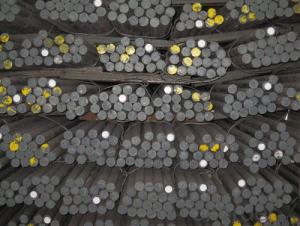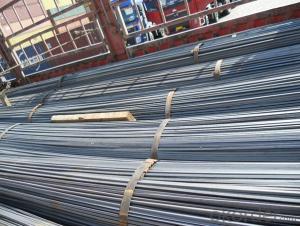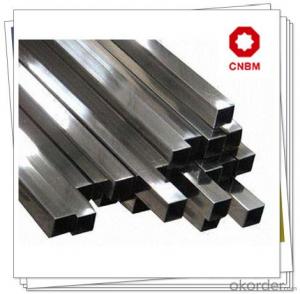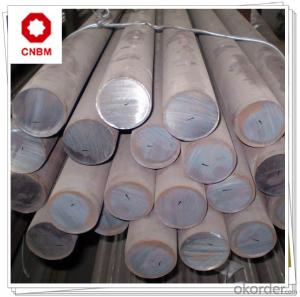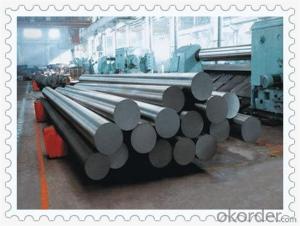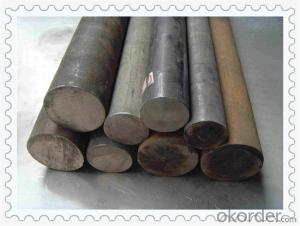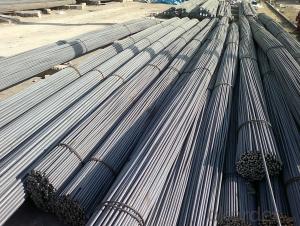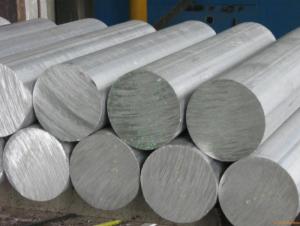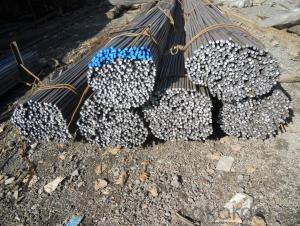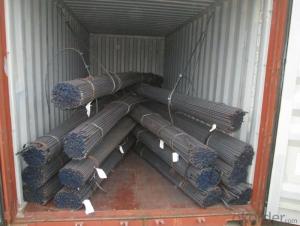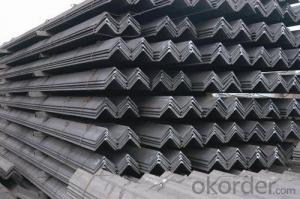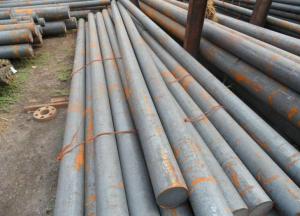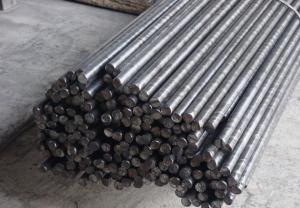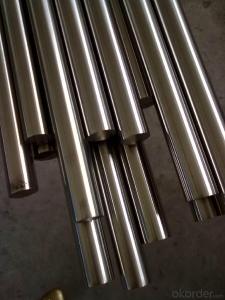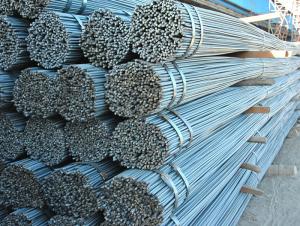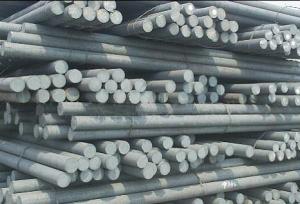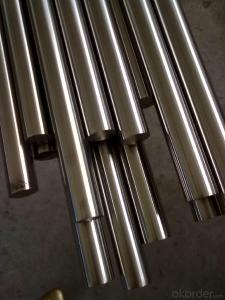low price of round bar hot rolled
- Loading Port:
- China Main Port
- Payment Terms:
- TT OR LC
- Min Order Qty:
- -
- Supply Capability:
- -
OKorder Service Pledge
OKorder Financial Service
You Might Also Like
Specifications
Hot rolled round bar
1)Sizes:10mm-600mm
2)Lengths:4m-9m,other lengths can be customised
3)Standard:GB
Hot rolled steel bar /alloy steel bar
Specification:
OD | Length | Material | Standard | Technique |
16-260mm | 6-12m or aques per request | 20# | GB ASTM DIN | Hot rolled |
16-350mm | 45# | |||
200-500mm | 45# | Forged | ||
20-250mm | 20Cr,40Cr,20-42CrMo | Hot rolled | ||
50-300mm | GCr15 |
Chemical component:
C | Mn | Si | P | S | Cr | Ni | Cu | |
0.18-0.24 | 0.50-0.80 | 0.17-0.37 | ≤0.035 | ≤0.035 | 0.70-1.00 | ≤0.030 | ≤0.030 | |
Application:
30Cr round steel bar is mostly used in carburized parts(oil quenching), such as: transmission gear, gear shaft, CAM, worm, piston pin, claw clutch, etc.
- Q: Are steel round bars suitable for marine propeller applications?
- Yes, steel round bars are suitable for marine propeller applications. Steel is a widely used material in marine engineering due to its high strength, durability, and corrosion resistance. Steel round bars provide the necessary strength and stiffness required for propeller applications, ensuring efficient propulsion and withstanding the harsh conditions of marine environments.
- Q: How do you identify the grade of a steel round bar?
- The grade of a steel round bar can be identified through several methods. One way is to check the markings or labels on the bar itself. Manufacturers often stamp or engrave the grade directly onto the surface of the bar. These markings typically include information such as the grade designation (e.g., 304, 316, 4140), which represents the specific alloy composition, and may also include additional details such as the heat or lot number. Another method is to refer to the mill test certificate (MTC) that accompanies the steel round bar. The MTC provides comprehensive information about the composition, mechanical properties, and other relevant specifications of the material. The MTC is usually issued by the steel mill or supplier and can be requested upon purchase. Moreover, visual inspection and physical testing can help identify the grade of a steel round bar. Visual inspection involves observing the bar's appearance, texture, and color. Different grades of steel may exhibit distinct characteristics, such as a shiny or matte finish, specific surface treatments, or variations in color due to different alloying elements. Physical testing methods, such as tensile or hardness testing, can provide further confirmation of the steel grade. These tests measure the mechanical properties of the material, such as its strength, ductility, and hardness. By comparing the test results with known standards and specifications for different steel grades, one can determine the grade of the round bar. In summary, to identify the grade of a steel round bar, one can check for markings on the bar, refer to the mill test certificate, visually inspect the bar, and perform physical tests to assess its mechanical properties.
- Q: What are the advantages of using nickel-molybdenum alloy steel round bars?
- There are several advantages of using nickel-molybdenum alloy steel round bars: 1. High strength and durability: Nickel-molybdenum alloy steel round bars have excellent strength and durability properties, making them suitable for use in high-stress applications. They can withstand heavy loads and provide long-lasting performance. 2. Corrosion resistance: The addition of nickel in the alloy enhances its corrosion resistance, making it resistant to various corrosive environments. This makes nickel-molybdenum alloy steel round bars ideal for use in industries where exposure to chemicals or moisture is common, such as the oil and gas industry or marine applications. 3. High temperature resistance: Nickel-molybdenum alloy steel round bars exhibit excellent heat resistance properties, allowing them to maintain their mechanical strength and structural integrity at high temperatures. This makes them suitable for use in applications where elevated temperatures are present, such as heat exchangers or power generation equipment. 4. Excellent machinability: Nickel-molybdenum alloy steel round bars can be easily machined and fabricated, allowing for various customization options. This makes them versatile and easily adaptable to different project requirements. 5. Weldability: These alloy steel round bars have good weldability, which means they can be easily joined to other components or structures using standard welding techniques. This makes them convenient for manufacturing processes and construction projects. 6. Cost-effective: Despite their excellent properties, nickel-molybdenum alloy steel round bars are relatively cost-effective compared to other high-performance alloys. This makes them a cost-efficient choice for various applications, providing value for money without compromising on quality. Overall, the advantages of using nickel-molybdenum alloy steel round bars include high strength, corrosion resistance, temperature resistance, machinability, weldability, and cost-effectiveness. These properties make them a preferred choice for various industries and applications where superior performance and durability are required.
- Q: How do steel round bars compare to aluminum round bars?
- Steel round bars are generally stronger and more durable than aluminum round bars. They have a higher tensile strength, making them suitable for heavy-duty applications that require high levels of strength and resistance to bending or deformation. Aluminum round bars, on the other hand, are lighter and more corrosion-resistant, making them ideal for applications that prioritize weight reduction and resistance to exposure to harsh environments. The choice between steel and aluminum round bars ultimately depends on the specific requirements of the application.
- Q: How are steel round bars used in the manufacturing of mining equipment?
- Due to their strength, durability, and versatility, steel round bars play a crucial role in the manufacturing of mining equipment. They are essential components used throughout the mining industry to ensure the reliability and longevity of the machinery. One primary application of steel round bars in mining equipment is for constructing frames and structural components. These bars provide the necessary structural support, ensuring the overall stability and robustness of the equipment. Whether it's excavators, drilling rigs, or conveyor systems, steel round bars are vital for maintaining the integrity of the machinery. Moreover, steel round bars are commonly utilized in manufacturing mining tools and attachments. They can be machined and shaped into various forms, such as shafts, pins, and bolts, which are essential for different mining operations. For instance, steel round bars are often used to make drill bits that can withstand high-pressure conditions while drilling into rock formations. Additionally, steel round bars are crucial for fabricating wear-resistant components in mining equipment. The harsh mining environments, including abrasive materials and extreme temperatures, require the use of durable materials. By using specific alloys and heat treatments, steel round bars can be employed to create wear-resistant parts like cutting edges, teeth, and buckets for excavators, ensuring their longevity and performance. Furthermore, steel round bars are also utilized in producing support structures and safety features in mining equipment. They can be used to create roll cages, protective frames, and guardrails, providing a safe working environment for operators and reducing the risk of accidents. Overall, steel round bars are vital components in the manufacturing of mining equipment. Their presence contributes to the strength, reliability, and performance of the machinery. Whether it's in construction, tool fabrication, wear-resistant components, or safety features, steel round bars ensure the durability and efficiency of mining machinery, enabling the industry to operate effectively and safely.
- Q: What is the difference between a polished and a precision ground steel round bar?
- A polished steel round bar refers to the process of buffing the surface to achieve a smooth and shiny finish, primarily for aesthetic purposes. On the other hand, a precision ground steel round bar undergoes a more precise grinding process to achieve tight dimensional tolerances and a smooth, accurate surface finish, primarily for functional purposes.
- Q: What are the advantages of using magnesium-alloy steel round bars?
- One advantage of using magnesium-alloy steel round bars is their high strength-to-weight ratio. These bars offer excellent strength and durability while being lightweight, making them suitable for applications where weight reduction is crucial, such as in aerospace and automotive industries. Furthermore, magnesium-alloy steel round bars exhibit good corrosion resistance, which extends their lifespan and makes them ideal for outdoor and marine applications. Additionally, these bars can be easily machined and formed, allowing for flexibility in design and fabrication processes.
- Q: What are the different machining processes used for steel round bars?
- Steel round bars can be machined using various processes to achieve specific outcomes and meet project specifications. Some commonly employed machining processes for steel round bars include the following: 1. Turning: By rotating the round bar and utilizing a cutting tool, material is removed to create the desired shape or size. This method is often employed to decrease the diameter or produce precise cylindrical shapes. 2. Drilling: Holes are created in the steel round bar using a rotating cutting tool called a drill bit. This process is frequently used for installing bolts, screws, or other fasteners. 3. Milling: Material is removed from the surface of the steel round bar using a rotating cutting tool with multiple teeth. This method is employed to create flat surfaces, grooves, or intricate shapes. 4. Grinding: Abrasive particles are used to remove material from the steel round bar, resulting in a smooth surface finish and achieving specific tolerances. This process is commonly used to refine the surface or eliminate imperfections. 5. Thread rolling: External threads are created on the steel round bar by pressing a hardened steel die against the rotating bar, causing the material to flow and form the desired threads. 6. Cold drawing: The steel round bar is pulled through a die, reducing its diameter and enhancing its surface finish. This process is utilized to achieve precise dimensions and improve the mechanical properties of the bar. 7. Heat treatment: Although not a machining process itself, heat treatment is often combined with machining to enhance the properties of the steel round bar. Processes like annealing, quenching, and tempering can improve hardness, strength, and toughness. These represent just a few of the numerous machining processes available for steel round bars. The selection of a specific process depends on factors such as the desired shape, size, surface finish, and mechanical properties required for the intended application.
- Q: Can steel round bars be used in the production of construction equipment?
- Yes, steel round bars can be used in the production of construction equipment. Steel round bars are commonly used in the construction industry for various applications, including the manufacturing of heavy machinery, equipment components, structural frames, and supports. The high strength and durability of steel make it an ideal material for constructing robust and reliable construction equipment.
Send your message to us
low price of round bar hot rolled
- Loading Port:
- China Main Port
- Payment Terms:
- TT OR LC
- Min Order Qty:
- -
- Supply Capability:
- -
OKorder Service Pledge
OKorder Financial Service
Similar products
Hot products
Hot Searches
Related keywords
